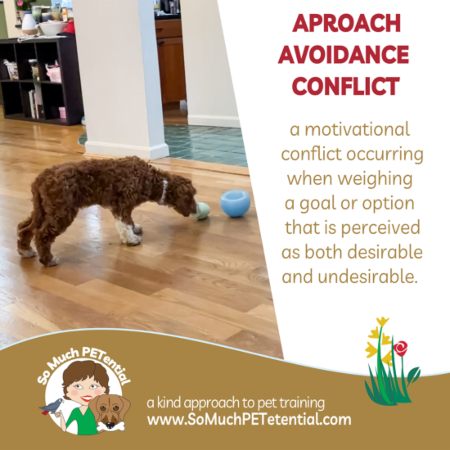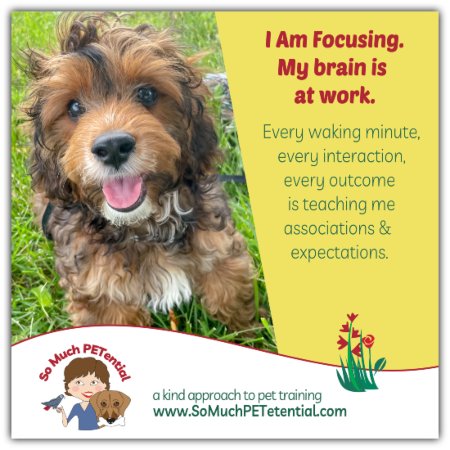If you have just brought a puppy into your home, NOW is the time to begin to build your relationship in a fun, loving and nurturing way. Your puppy needs to learn from you that his world is safe, that his needs will be met, and that YOU are worth listening to because good things happen when he does.
Remember, to help your puppy learn the habits you want to see more of, while preventing practice of unwanted behaviors,  management (preventative strategies) is very important. It takes a split second for a puppy to squat. Active supervision is absolutely important.
management (preventative strategies) is very important. It takes a split second for a puppy to squat. Active supervision is absolutely important.
Below are a few generalized puppy training tips to keep in mind.
SOCIAL NEEDS
When a puppy is not sleeping, he will have a need to play, chew, eat, and poop. He will also have a need to explore his world and come to see it as a positive, safe place.
This means, if you work long hours (especially if you have no other pets), you should make arrangements to find a way of getting home for breaks or having someone visit with your puppy. You can do training, play, bringing your puppy outside, and doing other enrichment in a 20 to 30-minute window before leaving your home. That activity will cause your puppy to need a nap for a few hours before repeating the cycle.
It is important to also spend time taking your puppy out in the world, to experience different sights, sounds, people, and other stimulus. However, note that those experiences should be short and have as one of the goals that your puppy learns at least a neutral if not positive association with stimulus and different environments.
You will probably want to invite guests over to meet your new addition. Your priority should be that your puppy have a positive experience and not be overwhelmed. Allow your puppy to approach people rather than them encroaching on his space. Ask guests to avoid loud, sudden movements; looming over your puppy; or chasing or grabbing your puppy. Watch your puppy’s body language. Does he have loose muscles? Is he moving toward or away from people? If your puppy’s body language tells you he wants distance or avoidance, or if he is getting too bitey/jumpy/zoomy, that is likely to be an indication that he needs space and/or rest.
Remember, those visits are also opportunities to be teaching your puppy the behaviors you want to see more of around new people.
HANDLING YOUR PUPPY
Teach your puppy early on that being touched is a good thing. Note that if your puppy shows any kind of fear such as backing up or leaning away from you, looking away, yawning, lip licking, rolling over, do not push interaction. Seek the help of a positive trainer.
You can begin by stroking your puppy beginning on the underside of his muzzle, then look inside his ears, touch his paws and his tail. This handling should be calm and you can pair stroking with treats. (Touch his ear, then give a treat; touch his paw and then give a treat.) You may have the most success if done in short sessions when your puppy is tired and/or relaxed.
When you bring your puppy to your veterinarian, bring lots of high value treats with you. Give some to the office staff to give your puppy upon arrival; and the vet techs and vet for examinations. After a shot, immediately give a treat.
PLAY
Until your puppy is about 14 weeks old (and even longer), he will be in a critical socialization period when lots of positive experiences are important. You will want your puppy to have lots of opportunities to learn his world is good; however, you should also try to teach your puppy that YOU are his primary source of fun and play. NOTE that if your puppy shows fear behaviors, your priority needs to focus on allowing him to interact with his environment at his own pace while not overwhelming him. Working with a positive trainer will be very helpful.
With puppies, playing with purpose is important as so may lessons can be taught through having fun together simply by arranging the game to teach the value of consequences. Also games like hide and seek can teach your puppy to value finding you.
Also keep in mind that ‘growth plates’ – soft areas at the ends of puppy bones – don’t close until dogs are about 18 months old so be careful with fast movements and too much exercise. And your puppy will have some sore gums during the teething months so being cautious with tugging is also a good idea.
Meeting Other Dogs
While getting to meet different dogs is important, it is also important that those interactions be positive experiences for your little friend. There are many adult dogs who can be too much for a young puppy. A good playmate is one that will set clear boundaries for your puppy but will also not physically hurt your puppy. Keep those meetings short – less than five minutes in the beginning. If your puppy is showing signs of fear of bigger dogs, you may want to start introducing your puppy to little dogs first.
Also, do not let your puppy be the harasser. If your puppy is not reading the other dog or puppy’s body language and doing too much of getting into the other dog’s space, redirect him.
COLLAR, LEASH, AND HARNESS
If your puppy is backing away from you when you are trying to attaching a collar, harness or leash, do not force the issue. Spend time teaching your puppy to move his head toward the equipment with treats. You can feed your puppy treats as you are attaching equipment in the beginning, and then again when it is on. Then take the equipment off.
CHEWING
Exercise, preventative strategies and appropriate chew choices are very important during teething phases. Protecting furniture with boards, pvc pipe, or other means will prevent your puppy from practicing using furniture as chew toys. .






